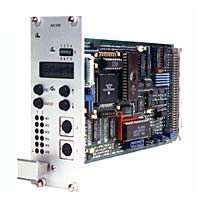AN308 – Digital Controller
AN308 – Digital Controller
The AN308 module is a further development of the familiar AN307 controller. Whereas the AN307 is intended principally for the processing of analog signals, the development objective for the AN308 was the additional ability to process signals from digital displacement sensors. This allows the AN308 to be used as a CNC controller.

The sensor system is of universal design so that the widest variety of sensors can be evaluated by exchanging a module (e.g. 4…20mA, ±10V, 7.5V±4V). In addition, an integral medium-frequency generator permits the connection of an inductive displacement sensor.
Interfaces are provided for SSI transmitters, incremental transmitters and ultrasonic displacement sensors (MTS). The ultrasonic displacement sensor is evaluated directly in the module.
To permit direct control of a proportional valve, the module is provided with PWM output stages with high dynamic response, allowing peak currents of more than 3A with a carrier frequency of 6kHz. To permit better adaptation to different valves, the coil current has three plug-selectable ranges (800mA, 1600mA, 3000mA).
The use of a 32 bit computer system achieves short cycle times, allowing drives with high dynamic demands to be controlled.
The quadruple digital/analog converter (12 bit resolution) allows this unit to be used for a wide range of applications so that even an external servo or regulating valve can be controlled. The outputs can be switched between ±10V, ±20mA and ±10mA.
The circuit is designed to allow the speed and acceleration to be calculated from the displacement and pressure signals, so that these can be fed into the controller as status variables. A variety of adaptations to characteristics and of signal limitations, precontrols and inversions are possible. Up to 3 controllers can be operated in a cascade.
The controller module has 16 digital inputs and 10 digital outputs. The inputs are used to control the module (enable, setpoint selection, etc.), while the outputs, which are implemented as high side drivers, are intended as status displays. Inputs and outputs are optically insulated.
Parameter assignment and setpoint pre-setting takes place in sets via an external computer (PC) or via the optional keyboard in conjunction with a display.
Communication with the module is via the 16 inputs or optionally via the serial interface or the analog inputs.
